BEE MAY 2020
Punta Prieta, Mulegé (part 1) — April 3, 2020
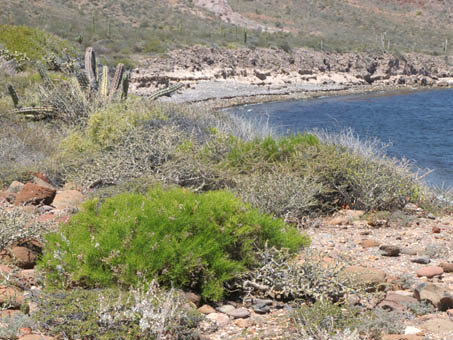 We have been sheltering-in-place per order of the Mexican goverment since the last week of March. So far, the state of BCS has been spared from the COVID-19 epidemic, compared with the interior of Mexico and the rest of the world. Travel up and down the peninsula has been greatly slowed so the chances of tourists and other travelers bringing it down is reduced, even though as I write this, Semana Santa or Holy Week is in progress, usually a time of the year when we see an influx of thousands of Mexicans on their 1-2 week vacation and the beaches are truly standing room only.
We have been sheltering-in-place per order of the Mexican goverment since the last week of March. So far, the state of BCS has been spared from the COVID-19 epidemic, compared with the interior of Mexico and the rest of the world. Travel up and down the peninsula has been greatly slowed so the chances of tourists and other travelers bringing it down is reduced, even though as I write this, Semana Santa or Holy Week is in progress, usually a time of the year when we see an influx of thousands of Mexicans on their 1-2 week vacation and the beaches are truly standing room only.
But the military has closed the beaches—they are basically empty—and all unnecessary businesses are on hiatus. Fortunately stores have plenty of food and...toilet paper!
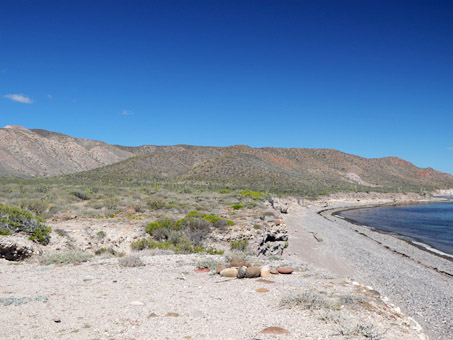 Since the desert scrub starts pretty much on the other side of our street here in our neighborhood, we are able to head out the front door for our walks or take short drives to uninhabited places closeby to explore.
Since the desert scrub starts pretty much on the other side of our street here in our neighborhood, we are able to head out the front door for our walks or take short drives to uninhabited places closeby to explore.
In this month´s entry, you´ll get to see what the desert is doing, and a bit of the pace of life here in this time of pandemia. Relax and enjoy!
The specific area I visited is located on the Gulf of California on the north side of the Mulegé river. The bluff trail stretches between the north end of the beach at Punta Prieta northward for several kilometers to Punta Colorado. It faces Bahía de Santa Inés.
Common species along the bluff include: Atriplex barclayana, Bajacalia crassifolia, Cylindropuntia cholla, Dalea mollis, Drymaria holosteoides var. holosteoides, Gundlachia diffusa, Maytenus phyllanthoides, and Perityle emoryi.

Beginning of the bluff trail, with vegetation typical for this coastal habitat. Soil is a mixture of alluvial flow (small to medium rounded rocks) overlaid with volcanic ejecta (tuff & lava).
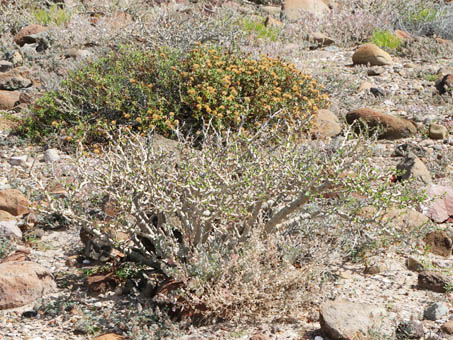
Front to back: Barclay Saltbush (Atriplex barclayana), Limberbush (Jatropha cuneata, Euphorbiaceae), Gulf Coast Bajacalia / Hierba del Venado (Bajacalia crassifolia, Asteraceae).
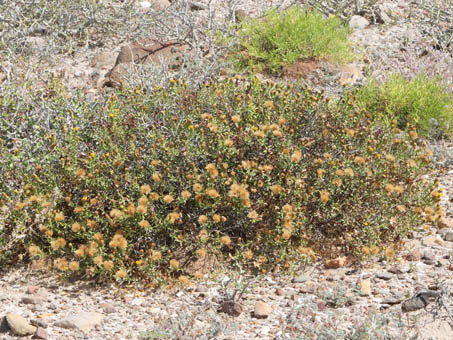
Bajacalia crassifolia gone to "seed". The leaves are succulent & glandular, with a pungent odor. Peninsular near-endemic.

Bajacalia crassifolia. Note the red glands on the phyllaries and leaf tips. (Photo is from 2016, a nearby location). The leaves are succulent & glandular, with a pungent odor.
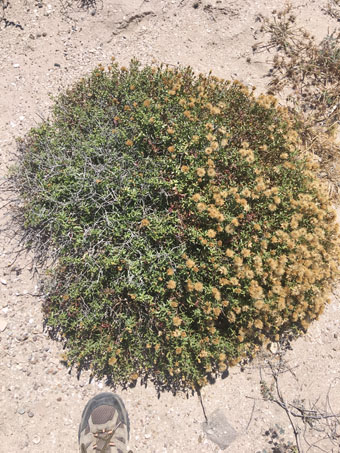
Bajacalia crassifolia with blown heads on right, the leeward side. Very few flowers on the windward side.
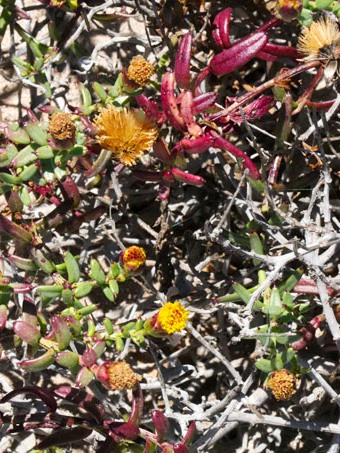
Bajacalia crassifolia. Flowers new and old. Note the red leaves which are extremely flattened and thickened, probably due to exposure to salt spray.

Edge of the bluff, the alluvial rocks exposed.
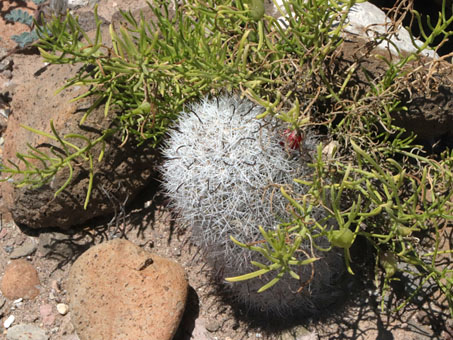
Mammillaria sp. partly protected by a young Gundlachia diffusa plant on the open bluff. It's thick white covering of interlocking spines make it well adapted to the site.
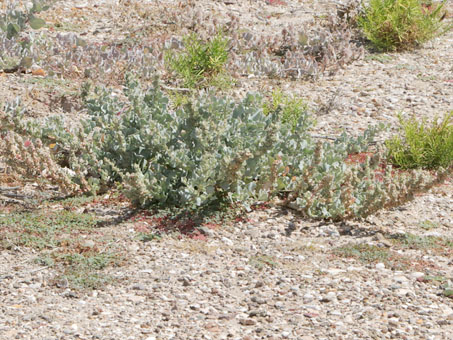
Barclay Saltbush/Chamiso (Atriplex barclayana, Chenopodiaceae) in foreground. The small, bright green shrubs are Sonoran Goldenbush (Gundlachia diffusa, Asteraceae).
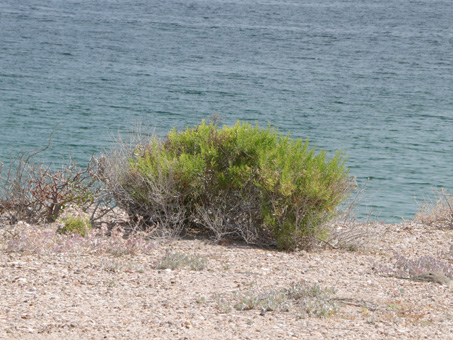
Sonoran Goldenbush/Hierba del Pasmo (Gundlachia diffusa). Leaves are filiform and resinous. In the area, found most commonly along the coast, especially in dunes. When elsewhere, usually in salty soils.
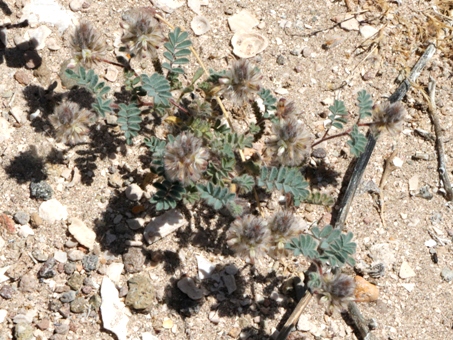
Silky Dalea (Dalea mollis, Fabaceae) is low and very hairy. It is common on coastal bluffs in this area.
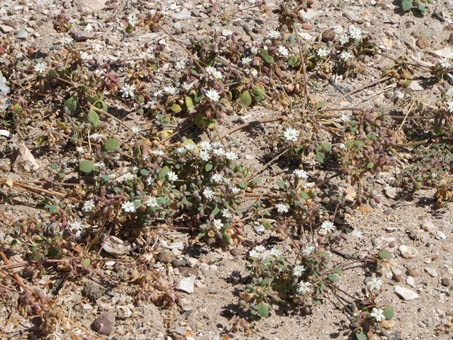
Another diminutive plant, Desert Drymaria / Ramitas Golondrina (Drymaria holosteoides var. holosteoides, Caryophyllaceae) has 5 deeply cleft petals. It is an annual, endemic to the peninsula, and found mostly along the coast on beaches, bluffs and hillsides.
Scrub on the Bajada (Alluvial Fan)
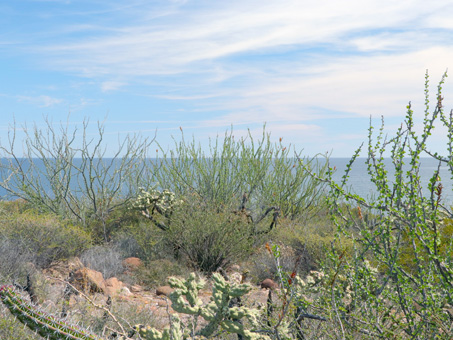
The last good rain was about 3-4 weeks ago. The White Tree Ocotillo / Palo Adán (Fouquieria burragei, Fouquieriaceae) was very leafy.
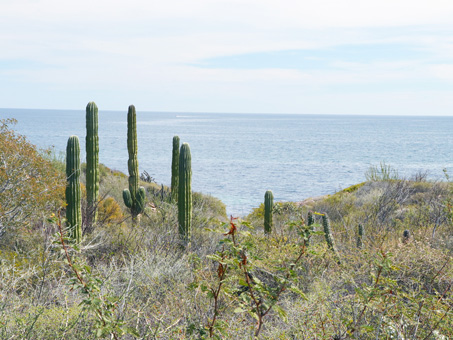
The vegetation along the trail was variable. It was especially dense in small gullies like this one where the shrubs were usually more leafy and taller than in the adjacent scrub.
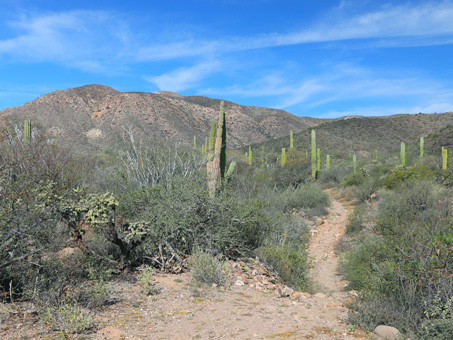
Away from the immediate bluff, the scrub of the alluvial fan is dense. The trail is easy going with a few dips into gravelly gullies.
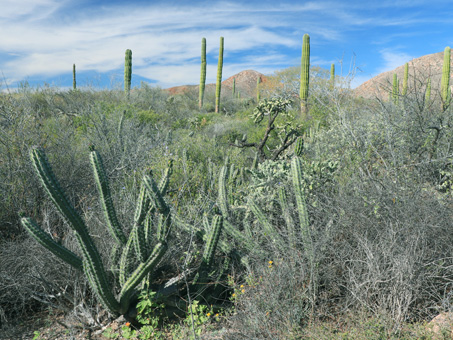
The desert out here, about 2 km from our neighborhood, is so quiet that birds and insects dominate the soundscape.
On this walk, besides eight species on the bluffs, I recorded a total of 60 species in the bajada scrub that backs the bluff: 31 shrubs and trees; 18 annual and perennial herbs; seven cacti; and four grasses. Below are some of these species, many of which had flowers or fruit. Others were going through the second or third round of new leaves since late summer. A list of the species recorded is included at the bottom of this section.
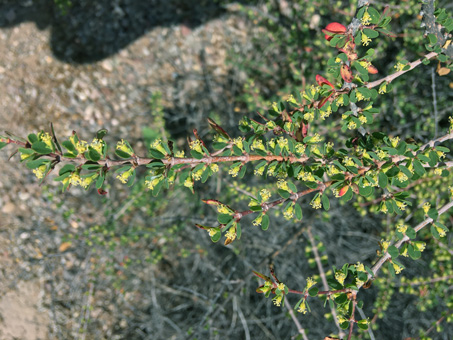
Magdalena Island Spurge / Golondrinón (Euphorbia magdalenae) is a near-endemic shrub common and widespread in this region, mostly on hillsides, bajadas and in arroyo beds. The flowers are about 4 mm L.
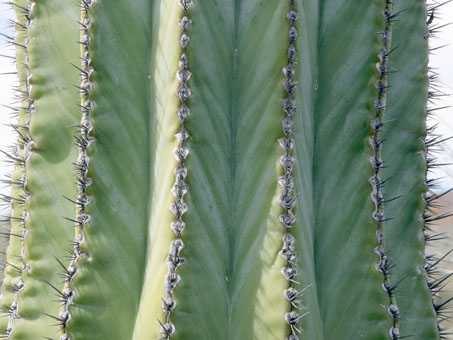
Ribs & spines of a fairly young Cardón stem (Pachycereus pringlei). The chevron markings are typical of the species. I´ve been on the lookout for signs of flower buds since early March, but out here, nothing yet.
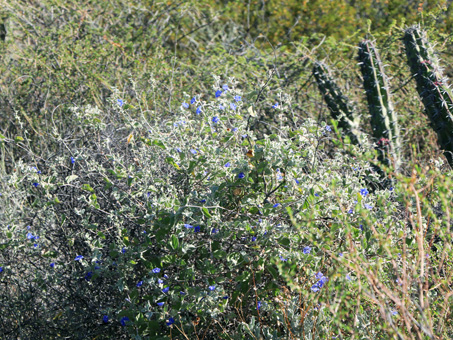
Eastwood Clustervine / Manto de la Virgen (Jacquemontia eastwoodiana, Convolvulaceae), a woody, bushy vine. It was blooming all over the area.
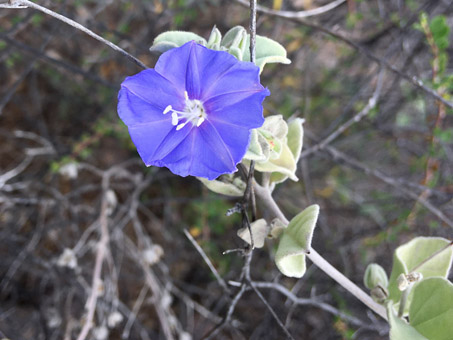
Flowers of Manto de la Virgen are about 3 cm D and pale to deep violet blue. The leaves are velvety.

Rock hibiscus / Malva Blanca (Hibiscus denudatus, Malvaceae). A small shrub. Leaves are thickened and densely pubescent.
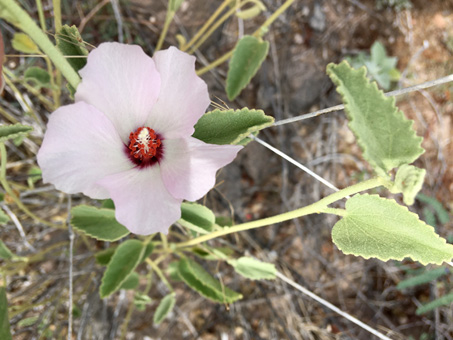
Rock hibiscus flowers are pale pink to lavender and about 3 cm D x 2-2.5 cm L. The anthers are deep red or even fuchsia.
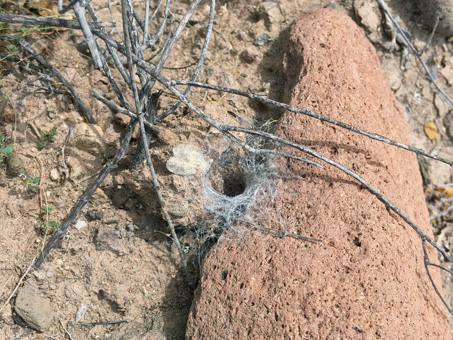
Most likely a Wolf Spider burrow. The opening is about 2 cm D. See this burrow from 2018. They are very common here and well hidden.
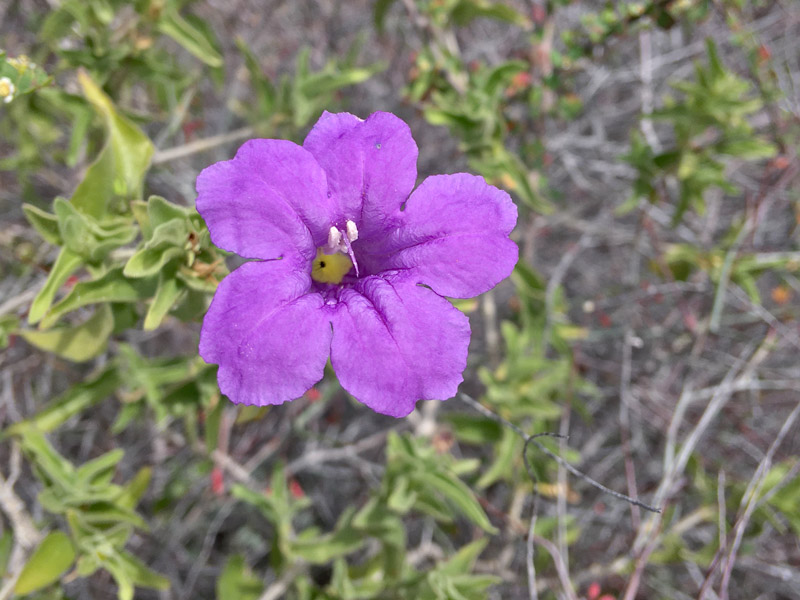
Flor de Campo/Baja California Wild-Petunia (Ruellia californica subsp. californica, Acanthaceae)
At one point, the trail dips into a small arroyo about 10 m wide with rocky walls about 3-4 m high. I took a detour up the arroyo to explore a little. The trees and shrubs are usually taller and lusher but less dense in these small gullies than on the bajada above them.
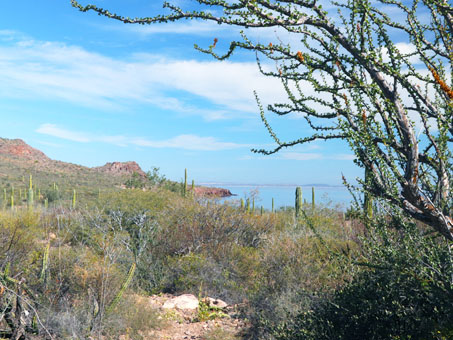
View from the trail of Punta Colorado to the north along Bahia Santa Ines just before the arroyo.
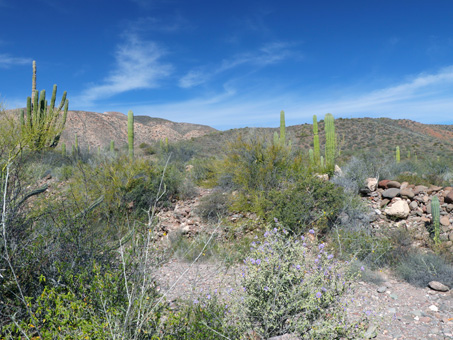
View from the trail before it descends into the small arroyo. Nightshade shrub in full bloom at center.
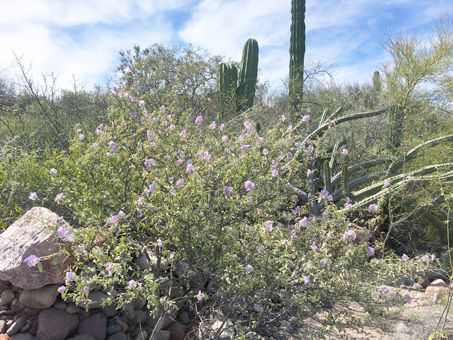
Baja California Nightshade / Mariola (Solanum hindsianum, Solanceae). It´s been a great year for this species across the peninsula, especially in disturbed areas, such as roadsides and along trails.
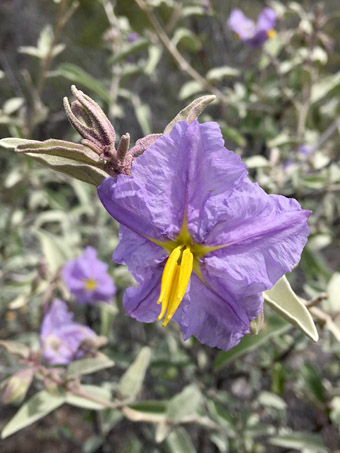
Baja California Nightshade (Solanum hindsianum). Flowers are about 4 cm D & range from pale lavender to purple.
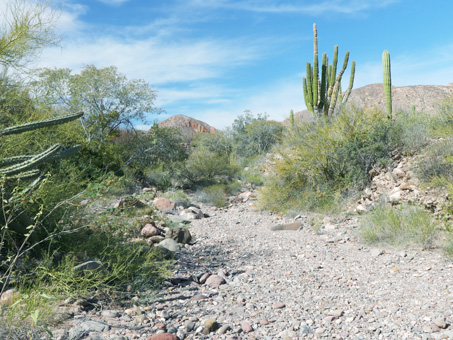
Looking west up the arroyo.
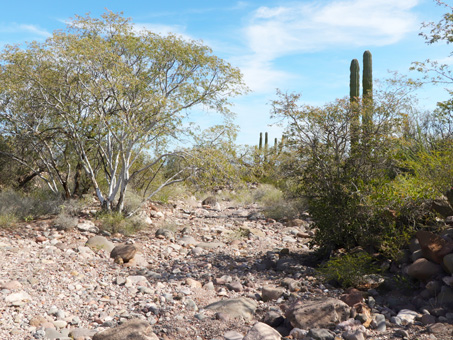
Looking east downstream toward the coast.
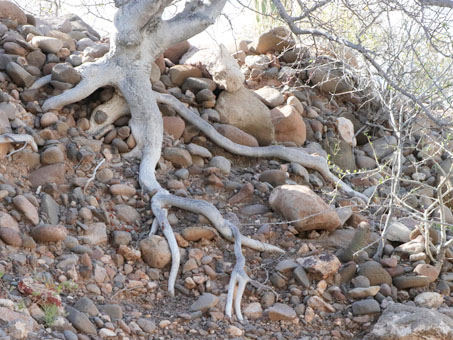
Torote prieto (Bursera hindsiana, Burseraceae) roots exposed as the walls of the arroyo erode.
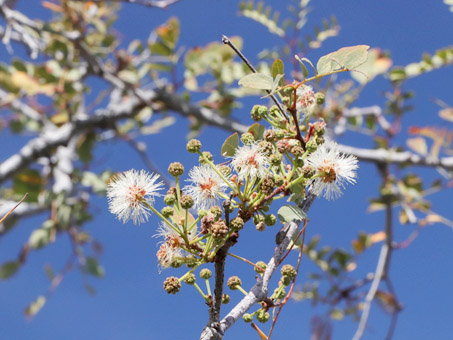
Palo blanco (Lysiloma candidum, Fabaceae) flowers are cream and about 1.5 cm D.
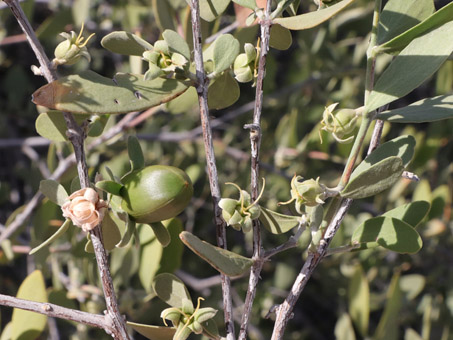
Jojoba (Simmondsia chinensis, Simmondsiaceae). The species is dioecious. Staminate flowers occur in small glomerules on a separate plant. Note the nut, and the pistillate (female) flowers. Check out this interesting fact-sheet on this species
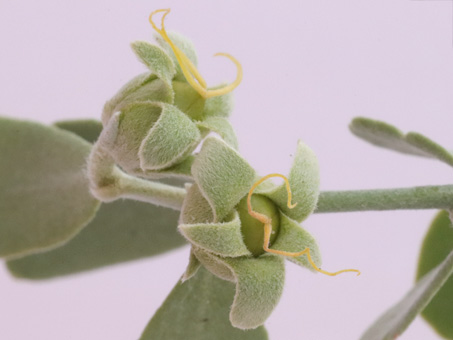
Jojoba (Simmondsia chinensis). Gotta love the furry petals. This is a pistillate flower. There are three style branches but one here was damaged and is no longer connected at the base. Plants are wind-pollinated.
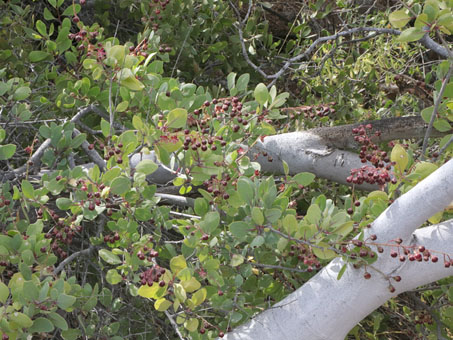
Tinta (Stegnosperma halimifolium, Stegnospermataceae) growing in the shade of a low cliff and Palo Blanco tree. See more on this species.
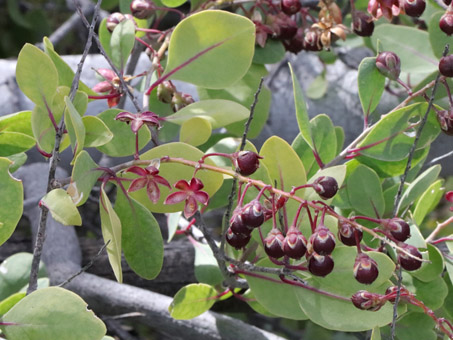
Tinta (Stegnosperma halimifolium, Stegnospermataceae). The fruit are capsules about 1 cm D, with a red aril attractive to birds.
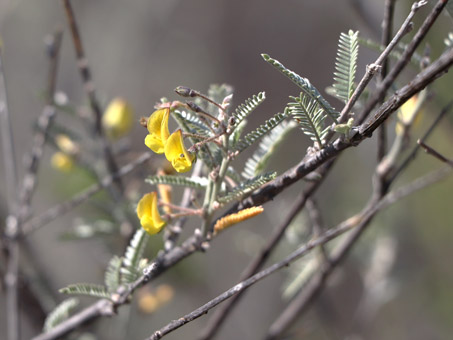
Vara prieta (Aeschynomene nivea, Fabaceae).
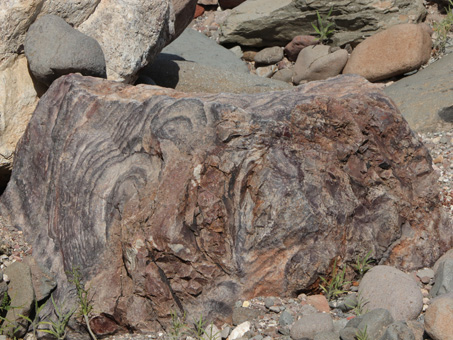
Interesting design in a volcanic boulder.
Along the shady edges of the southern wall of the arroyo, there were signs from many species of new growth, mostly annuals: rock daisies, Sweet Bush, Slim-jim bean, Hojasen, Tomatillo, and Pegarropa (Blazing Star).
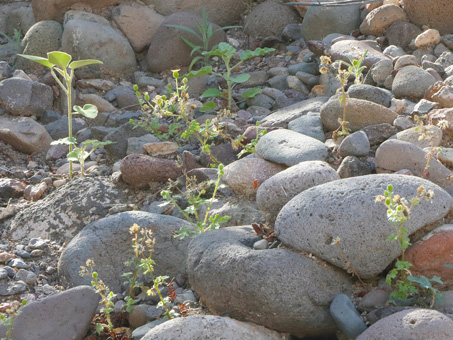
Mostly Emory Rock Daisy (Perityle emoryi), a small annual. These are under 15 cm H.
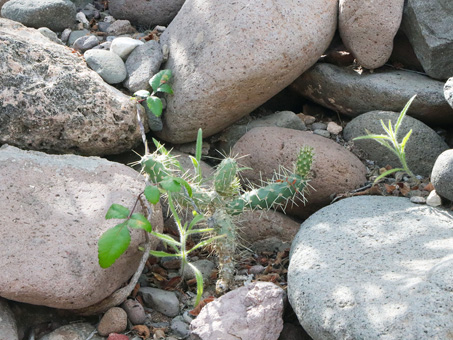
These youngsters are apparently growing right under their parents just above them on the arroyo wall. From L to R: Bursera hindsiana, Bebbia juncea (Sweetbush), Cholla peluda (Cylindropuntia alcahes var. alcahes) and another Sweetbush. The Cholla is actually a clone, a stem that fell off and took root below the main plant.
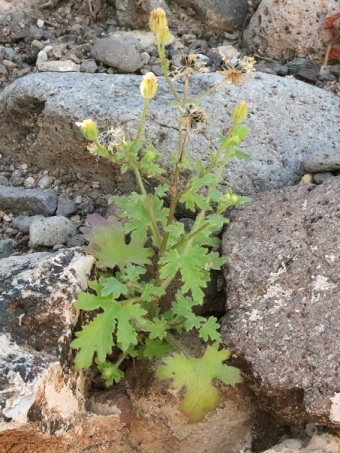
Emoryi Rock Daisy (Perityle emoryi), a small annual. Ray flowers are 3-5 mm L, disk flowers are yellow. The herbage is glandular-tacky with a strong odor.
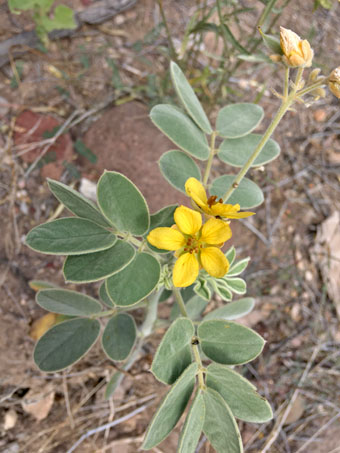
Hojasen (Senna confinis, Fabaceae). This is an endemic annual. Herbage is densely pubescent and velvety.
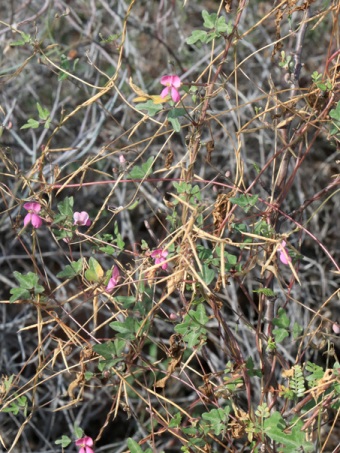
Slim-Jim Bean/Frijolillo (Phaseolus filiformis). The new growth here is clambering over previous stems of this annual bean.
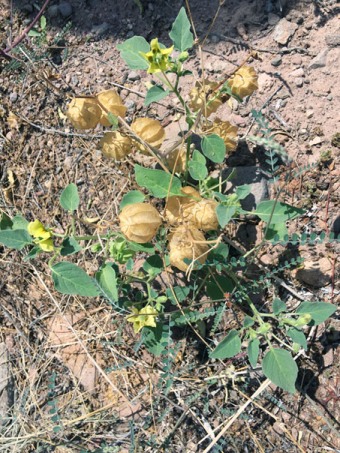
Ground-Cherry/Tomatillo plant (Physalis crassifolia var. crassifolia).

Apricot Globemallow (Sphaeralcea ambigua, Malvaceae).
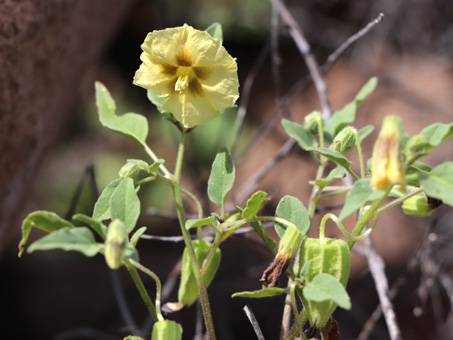
Ground-Cherry/Tomatillo plant (Physalis crassifolia, Solanaceae).
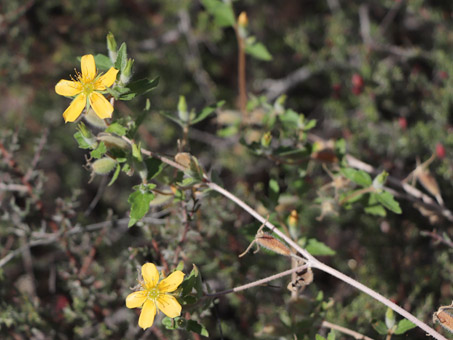
Pegarropa/Blazing Star (Mentzelia adhaerens, Loasaceae).
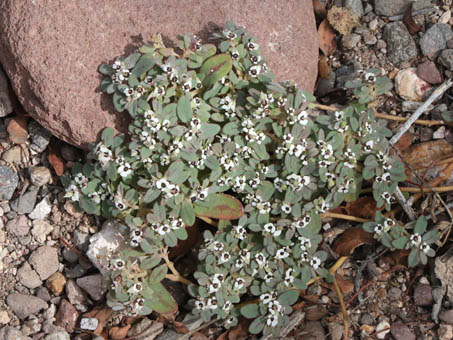
Louse Spurge / Golondrina (Euphorbia pediculifera var. pediculifera).

The yellow-orange haustoria of a parasitic Dodder (Cuscuta legitima, Convolvulaceae) can be seen low on the ground in 2 m square patch.
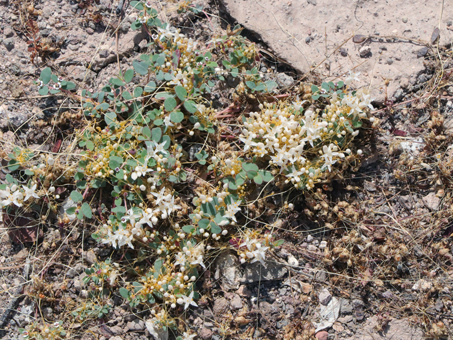
Small-seed Sandmat / Golondrina (Euphorbia polycarpa var. polycarpa) being parasitized by Dodder.
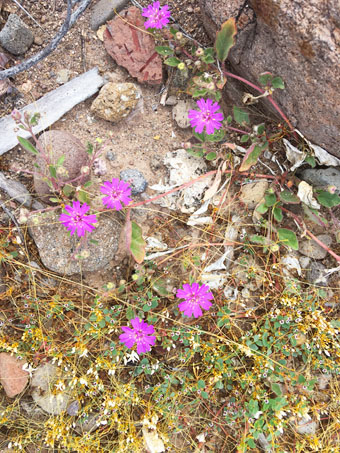
Windmills / Hierba de la Hormiga (Allionia incarnata), Euphorbia polycarpa and Cuscuta legitima.

Windmills / Hierba de la Hormiga (Allionia incarnata, Nyctaginaceae).
Species List for the Bajada
Species listed below in bold type were not featured in this month's entry. Links are provided to some of these if there are existing photos on this site.
Shrubs and trees: Aeschynomene nivea, Ayenia compacta (California ayenia), Bebbia juncea var. juncea, Bursera hindsiana, Bursera microphylla, Callaeum micropterum (Hillyhock, Gallineta), Colubrina viridus Cordia parvifolia (Little-leaf Cordia, Vara prieta), Cottsia gracilis (Slender Janusia, Fermina), Desmanthus fruticosus (Baja California Bundleflower; Daí, Frijolillo), Euphorbia magdalena, Fouquieria burragei, Galphimia angustifolia (Narrow-leaf Goldshower), Hibscus denudatus, Hoffmannseggia intricata (Gulf Rush-pea), Horsfordia newberryi, Jacquemontia eastwoodiana, Krameria erecta, K. pauciflora Larrea tridentata (Creosote, Gobernadora), Lycium andersonii var. pubescens (Hairy Desert Thorn), Lysiloma candidum, Marina parryi (Parry marina), Melochia tomentosa (Teabush, Malvarosa), Olneya tesota (Desert Ironwood), Parkinsonia microphyllum (Palo Verde, Dipua), Prosopis articulata (Mesquite), Ruellia californica subsp. california, Simmondsia chinensis, Solanum hindsianum, Tephrosia palmeri (Palmer Hoary-Pea, Frijolillo).
Cacti: Cylindropuntia alcahes var. alcahes, Cylindropuntia cholla, Echinocereus bigelovii, Lophocereus schottii, Mammillaria dioica, Pachycereus pringlei, Stenocereus gummosus
Annual and perennial herbs: Allionia incarnata, Amaranthus watsonii, Cuscuta legitima, Datura discolor, Ditaxis brandegeei var. brandegeei, D. lanceolata, Eriogonum inflatum, Euphorbia pediculifera, E. polycarpa, E. setiloba, Hofmeisteria fasciculata var. fasciculata (Coast Hofmeisteria), Mentzelia adhaerans, Perityle californica, P. emoryi, Phaseolus filiformis, Physalis crassifolia, Porophyllum gracile (Slender Poreleaf, Odora, Hierba del Venado), Pseudorontium cyathiferum, Senna confinis, Sphaeralcea ambigua.
Grasses: Aristida adscensionis (Six-weeks Three-awn, Zacate tres barbas), Bouteloua aristidoides (Needle Grass, Navajitas), Cenchrus ciliaris (Buffelgrass, Zacate bufel), Cenchrus palmeri (Southern Sand-bur, Huizapol).
Life in the Time of "la Pandemia"
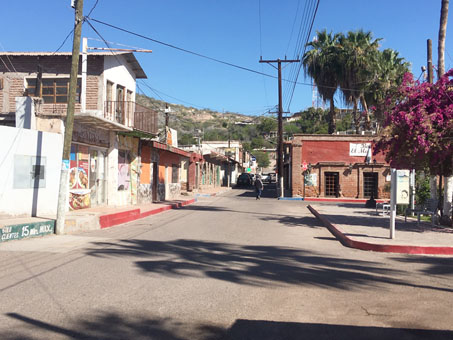
Holy Friday in downtown Mulegé. Deserted at the usual peak of this holiday weekend.

Returning from town, I like to stop to rest on the "andador" (river walk). Usually deserted, today three of us are demonstrating excelent social distancing practices; the two behind me are barely visible.
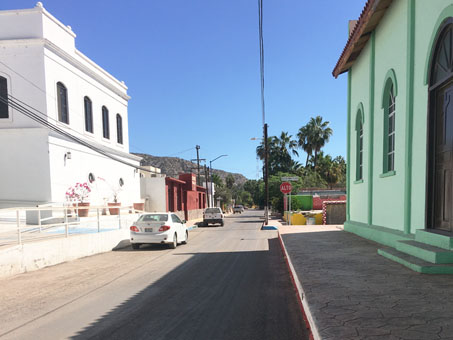
Holy Friday outside the main church and town government offices. Church doors were shuttered. Mass was being televised via Facebook.
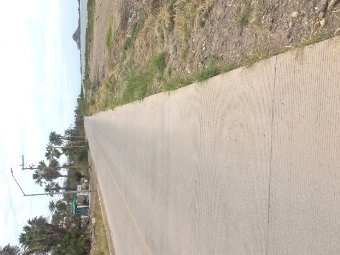
The heavy commute hour traffic.
I hope you´ve enjoyed this month´s entry and it got you "outside" for a little vicarious botanizing. Never know what will be around the next bend or down some little trail, so until next month, stay safe and hasta pronto...
Debra Valov—Curatorial Volunteer
References
Rebman, J. P., J. Gibson, and K. Rich, 2016. Annotated checklist of the vascular plants of Baja California, Mexico. Proceedings of the San Diego Society of Natural History, No. 45, 15 November 2016. San Diego Natural History Museum, San Diego, CA. Full text available online.
Rebman, J. P and Roberts, N. C. (2012). Baja California Plant Field Guide. San Diego, CA: Sunbelt Publications. Descriptions and distribution.
Wiggins, I. L. (1980). The Flora of Baja California. Stanford University Press. Keys and descriptions.



























































